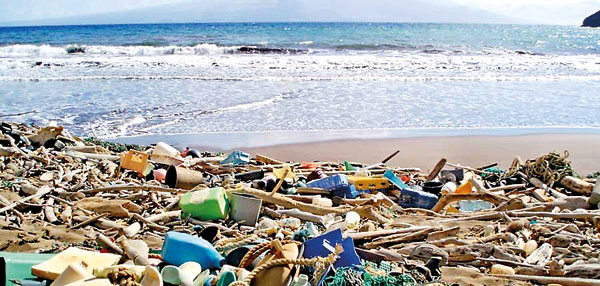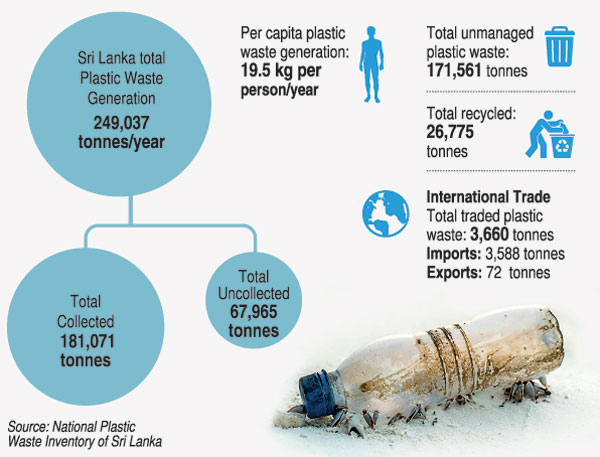News
Every urban dweller adds 28 kilos to Sri Lanka’s plastic waste pile every year
View(s):By Malaka Rodrigo
Following World Environment Day on June 5, with its focus on “Putting an End to Plastic Pollution,” World Ocean’s Day recently highlighted the need to address plastic contamination, particularly its impact on marine environments.
At the official Ocean’s Day Ceremony in Port City, Emeritus Professor of Ecology, Prof. Sarath Kotagama, underscored the severity of the issue, citing alarming new research.

Prof. Sarath Kotagama addressing the ceremony
“Microplastics are now even in the human brain, so we urgently need to act quickly to reduce our plastic pollution,” said Prof. Kotagama.
He referenced a recent study by the University of New Mexico, US, which found that human brain samples collected at autopsy in early 2024 contained significantly more microplastic than those from eight years before. The study revealed concentrations of 4,800 micrograms per gram – or 0.48% by weight – in the brain tissue of normal individuals with an average age of 45-50. This amount is equivalent to an entire standard plastic spoon.
Microplastics are tiny plastic particles, less than 5 millimetres in size, mainly formed when larger plastic waste breaks down due to sunlight, wind, ocean waves, or mechanical abrasion. These microplastics, and even smaller nanoplastics, can enter human bodies through ingestion or inhalation.
Prof. Kotagama shared a striking example from his own research: “Several years back, one of my students found microplastics in the feathers of egrets, birds that inhabit water-associated habitats. How can bird feathers get microplastics – the bird would not intentionally eat plastic or polythene, but would have come through food chain.’’ It illustrated how deeply ingrained plastic pollution has become in Sri Lanka’s ecosystems. Similarly, microplastics can get accumulated in our bodies too, he explained.
When the Ministry of Environment offered Prof. Kotagama a token of appreciation, he returned to the podium to refuse it, as the gift was made of plastic.
“We have to set ourselves the example and start taking actions by ourselves,” the seasoned environmentalist told the stunned crowd, emphasising the importance of personal responsibility in combating plastic pollution.

Plastic pollution has become deeply ingrained in Sri Lanka’s ecosystems
Sri Lanka faces a significant challenge with plastic waste, generating 249,037 metric tonnes a year. According to last year’s “National Plastic Waste Inventory for Sri Lanka,” about 171,561 tonnes (about 69%) of this plastic waste goes unmanaged. This includes uncollected waste that may be buried, burned, or escapes into the environment before or within the waste management system.
Dr. Anurudda Karunarathna of Peradeniya University, the report’s main author noted that these figures are particularly only on plastic waste – not organic wastes.
The “National Plastic Waste Inventory for Sri Lanka,” launched last year, is the second comprehensive study of its kind after Ghana to use a modern material flow analysis methodology, Dr.Karunarathna told the SundayTimes.
The total plastic waste generation in urban areas is significantly lower than in rural areas according to the study and this is a result that 82% of the population residing in rural areas. However, when considering per capita plastic waste generation, urban areas have the highest at 28.6 kg a year per person, compared with 9.1 kg/year/person in rural areas according to Dr.Karunarathna. An estimated 67,965 tonnes (27%) of plastic waste is not collected at all, often being burned, illegally dumped, or buried on site.

Plastic pollution is widespread in South Asia, recognised as one of the worst-affected regions globally. To address this collectively, the Plastic Free Rivers and Seas for South Asia (PLEASE) initiative was launched. Funded by the World Bank and implemented by the South Asia Cooperative Environment Programme (SACEP) with support from UNOPS, PLEASE is the region’s largest effort to combat marine plastic pollution and promote sustainable plastic use. Its seventh round table meeting was recently held in Colombo, bringing together innovators and financial resources to tackle the issue.
The PLEASE project has significantly contributed to establishing waste management initiatives in Sri Lanka and its six participating South Asian countries.
According to SACEP Director General, Norbu Wanchuk, the project has enabled the recycling of over 626,000 kilograms of plastic waste into useful resources.
Collectively, South Asian waste management companies, civil society groups, and communities have prevented 10.2 million kilos of plastic waste from polluting rivers and seas over the past five years.
The best way to say that you found the home of your dreams is by finding it on Hitad.lk. We have listings for apartments for sale or rent in Sri Lanka, no matter what locale you're looking for! Whether you live in Colombo, Galle, Kandy, Matara, Jaffna and more - we've got them all!

